FMLec M4 | Microbiota of Food Products
1/94
There's no tags or description
Looks like no tags are added yet.
Name | Mastery | Learn | Test | Matching | Spaced |
|---|
No study sessions yet.
95 Terms
3 factors influencing the microbiota of food products
Intrinsic food properties
Natural characteristics of food itself that affect microbial growth, including pmonab
pH
Moisture content
Oxidation-reduction potential
Nutrient
Antimicrobial constituents
Biological structures
Extrinsic process variables
Environmental conditions surrounding the food that impact microbial survival, including srg
Storage temperature
Relative humidity
Gases
Implicit microbial characteristics
Biological traits of microbes themselves that influence their ability to dominate a food environment
Microbial interactions and their beneficial/adverse effects, including cmmca
Competition
Metabiotic
Mutualism
Commensalism
Antagonism
T/F: Fruits with covering will spoil faster than those without
FALSE
Fruits without covering will spoil faster than those with covering (intrinsic parameter)
Which parameter?
Inherent part of the tissues
Some offer natural preservation
Allows prediction of the general type of microorganisms likely to grow
Contributes to the overall stability of food
Intrinsic parameters
Enumerate 5 intrinsic parameters/food properties
pmonab
pH
Moisture content
Oxidation-reduction potential
Nutrient
Antimicrobial constituents
Biological structures
_ is the optimum pH for most microorganisms
Neutral (6.5 - 7.5)
From most acidic to most basic
HCl > Lemon juice > Vinegar > Tomato > Banana > Potato > Water > Eggs > Baking soda > Bleach
Acidic foods: pH < 6.5 (e.g., fruits, fermented dairy)
Neutral foods: pH 6.5–7.5 (e.g., fresh meat, milk)
Alkaline foods: pH > 7.5 (e.g., egg whites, some seafood)
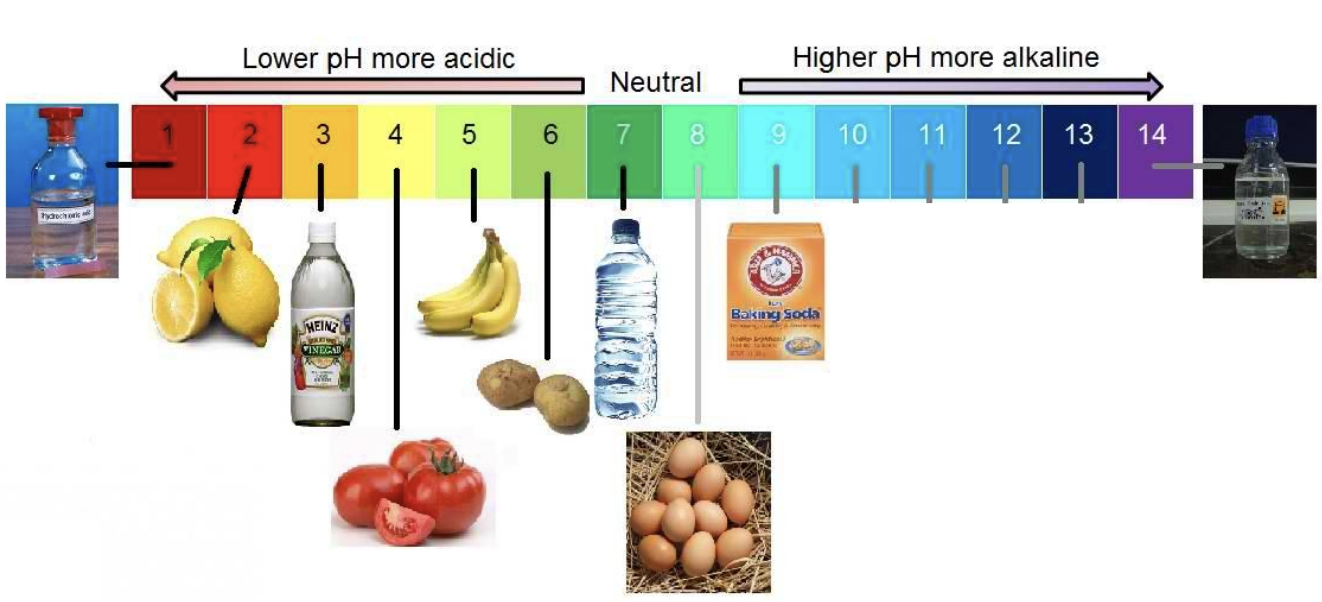
Rank from most acidic to most basic
Tomato, bleach, baking soda, lemon juice, vinegar, potato, HCl, eggs, water, banana
HCl > Lemon juice > Vinegar > Tomato > Banana > Potato > H2O > Eggs > Baking soda > Bleach
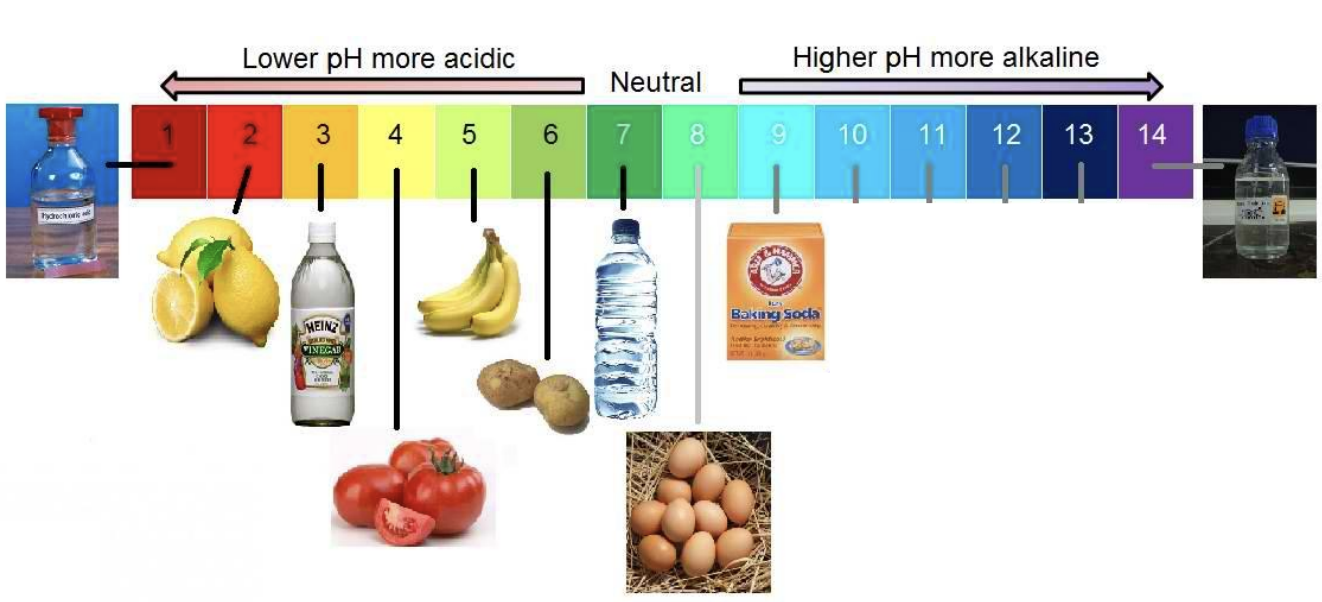
Food with pH around _ range would be more exposed to a higher diversity of microorganisms and thus would spoil faster
neutral (6.5 - 7.5)
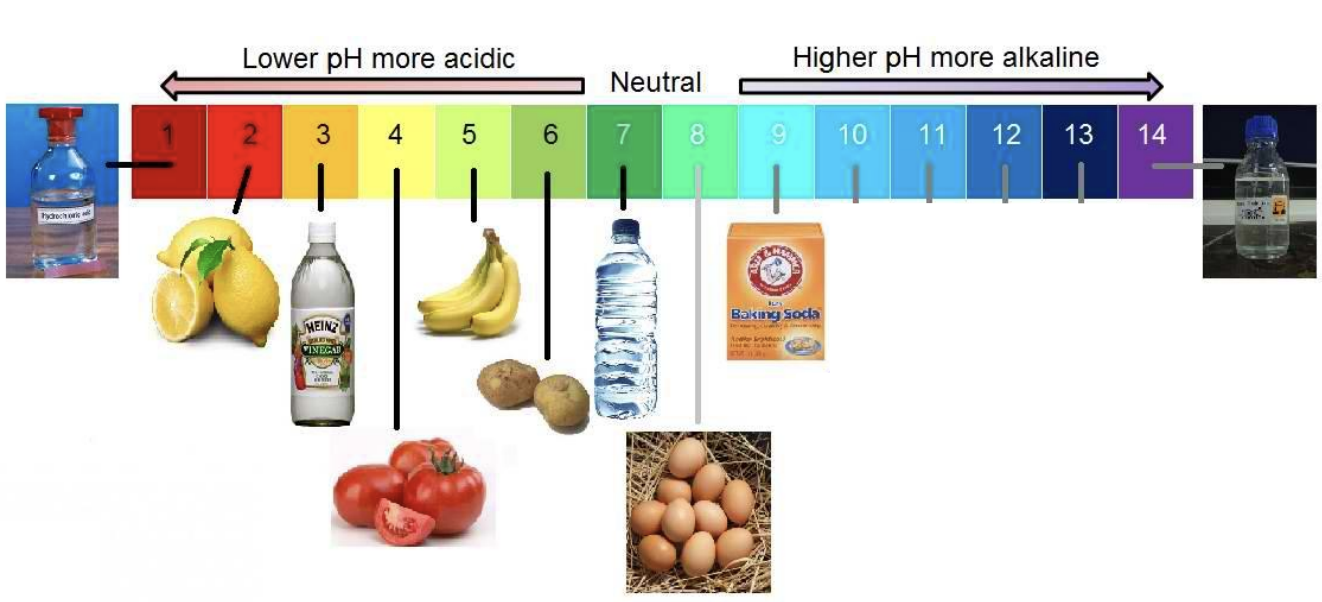
Rank the ff. from those w/ highest acid tolerance to least
LAB
Molds
S. aureus
Vibrio
Yeast
Molds > Yeast > LAB > S. au > Vibrio mylsv
The most fastidious microbes in terms of pH (i.e., can only tolerate a narrow pH range) are _
pathogenic bacteria
e.g., Salmonella spp., L. monocytogenes, Yersinia, C. botulinum, B. cereus, Campylobacter spp., Shigella spp., V. cholerae, C. perfringens
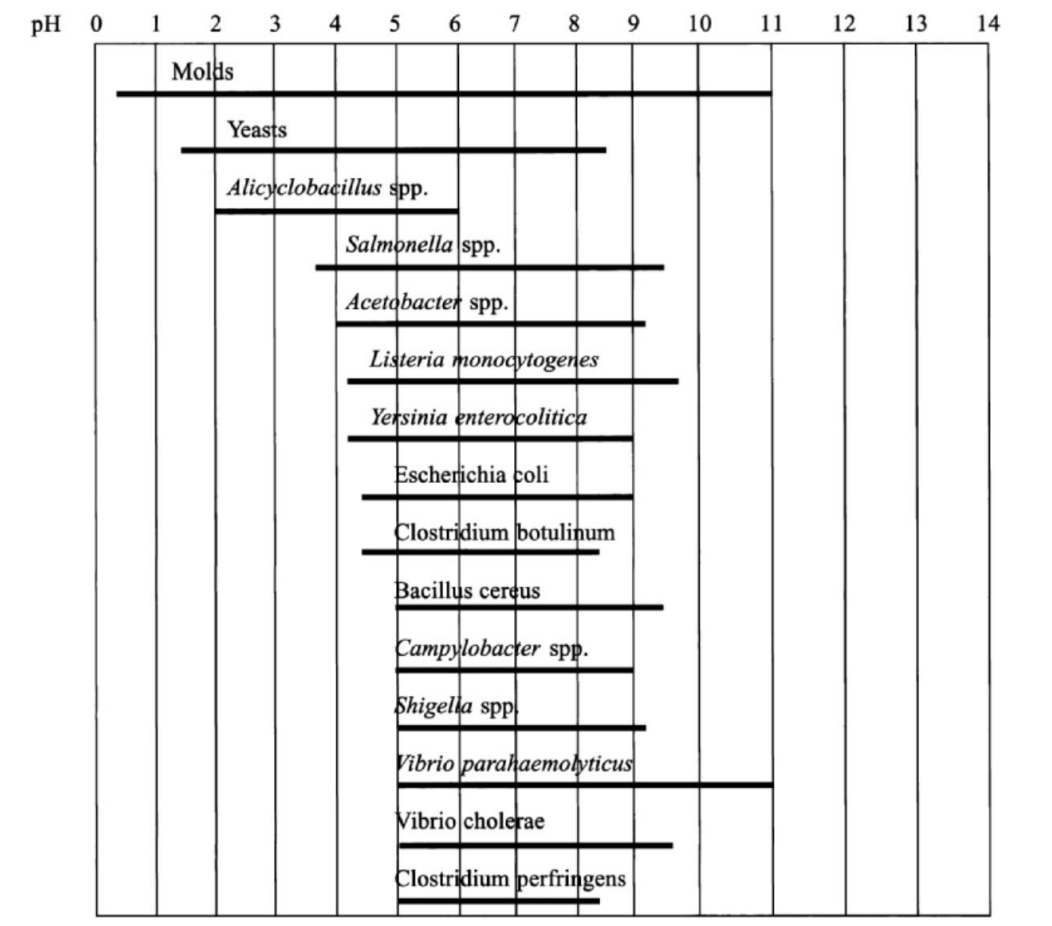
T/F: Acidic food products (pH < 4) are generally safer from bacterial contamination, except for a few species like Alicyclobacillus spp. and Acetobacter spp.
TRUE
Most bacterial pathogens struggle below pH 4, but acid-tolerant bacteria like Alicyclobacillus spp. and Acetobacter spp. can survive
T/F: Both V. parahaemolyticus and molds can survive in highly basic environments (pH = 11)
TRUE
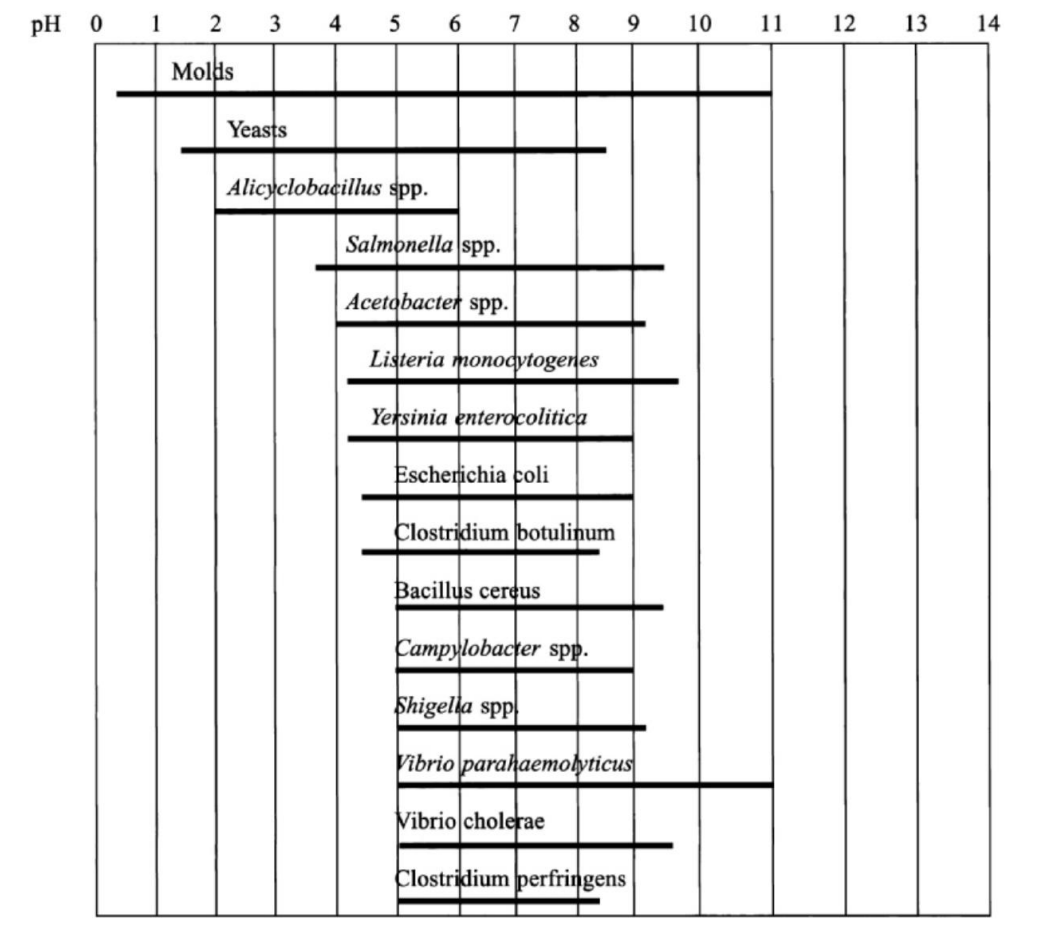
_ are very resilient and can growth within pH 0.5 (acidic) to 11 (basic)
Molds
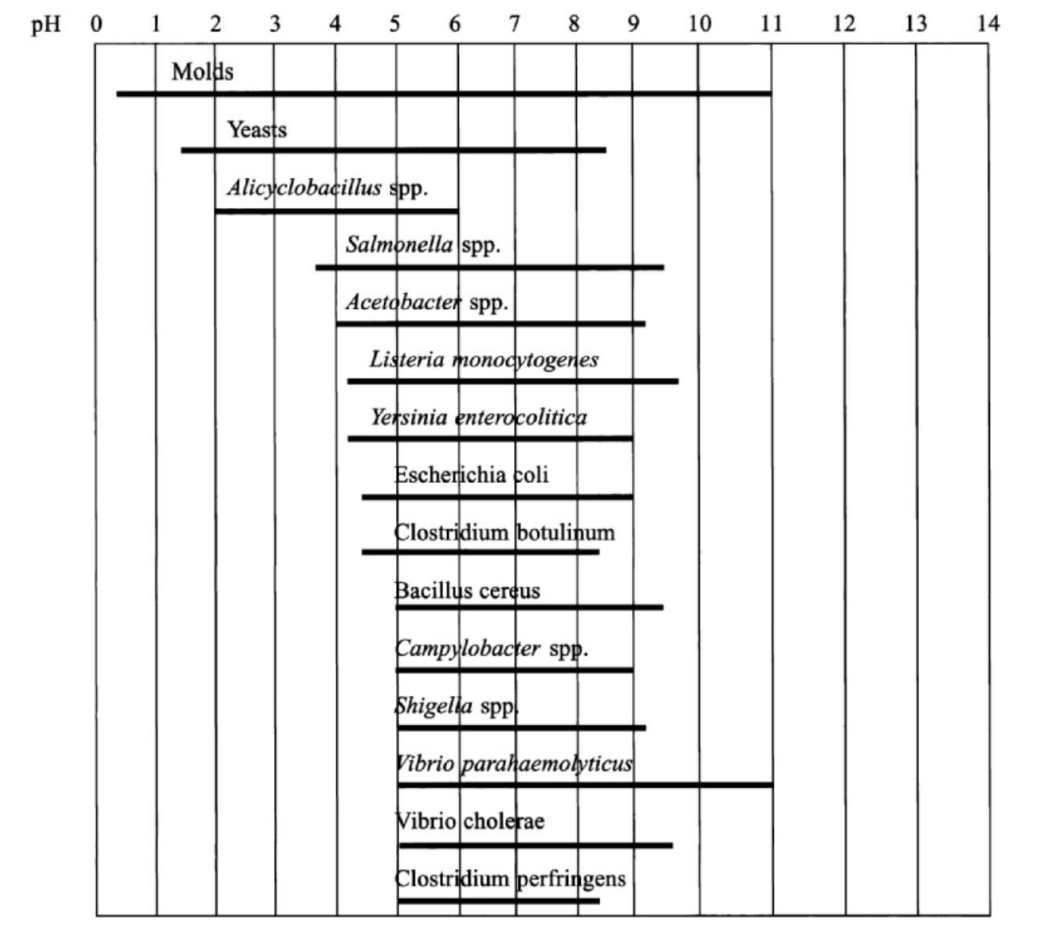
T/F: Bacteria are more fastidious than fungi in terms of pH requirement
TRUE
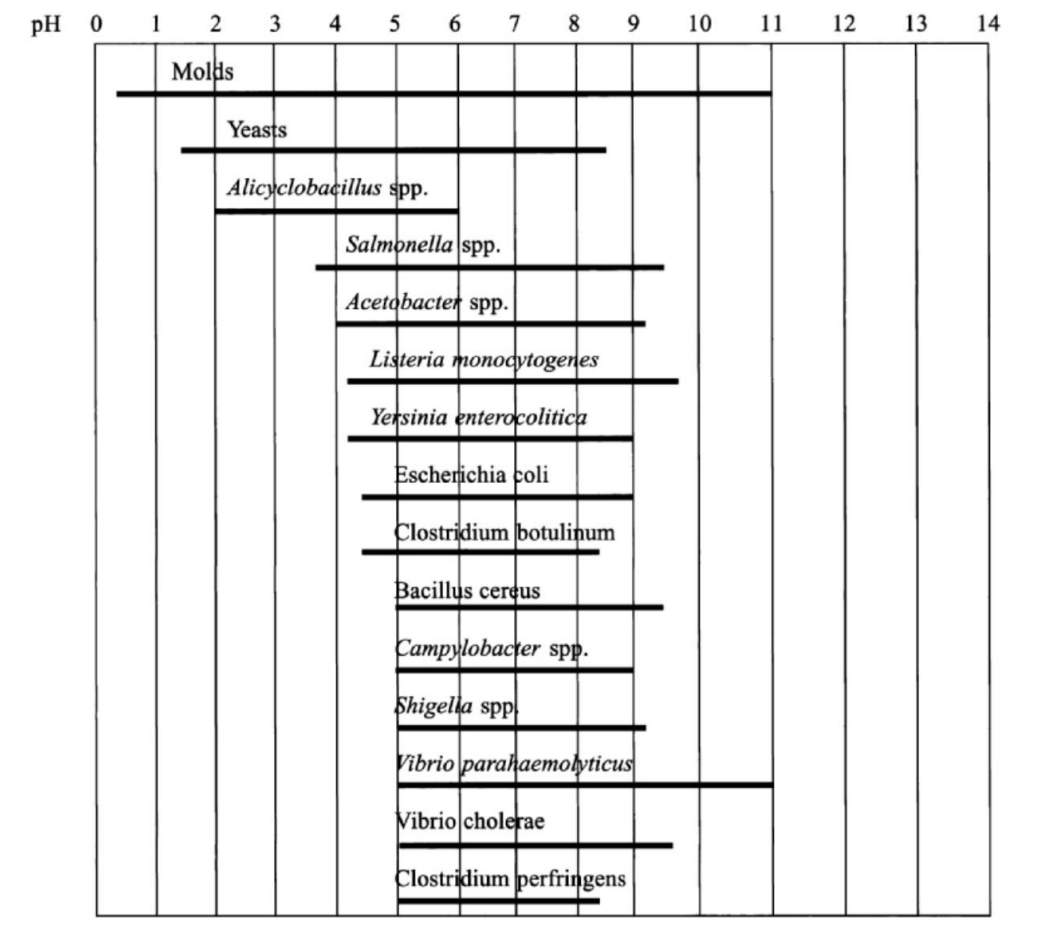
T/F: Bacteria would have a lower pH minima than fungi
FALSE
Fungi are less fastidious than bacteria in terms of pH range and can thus survive much lower pH than bacteria
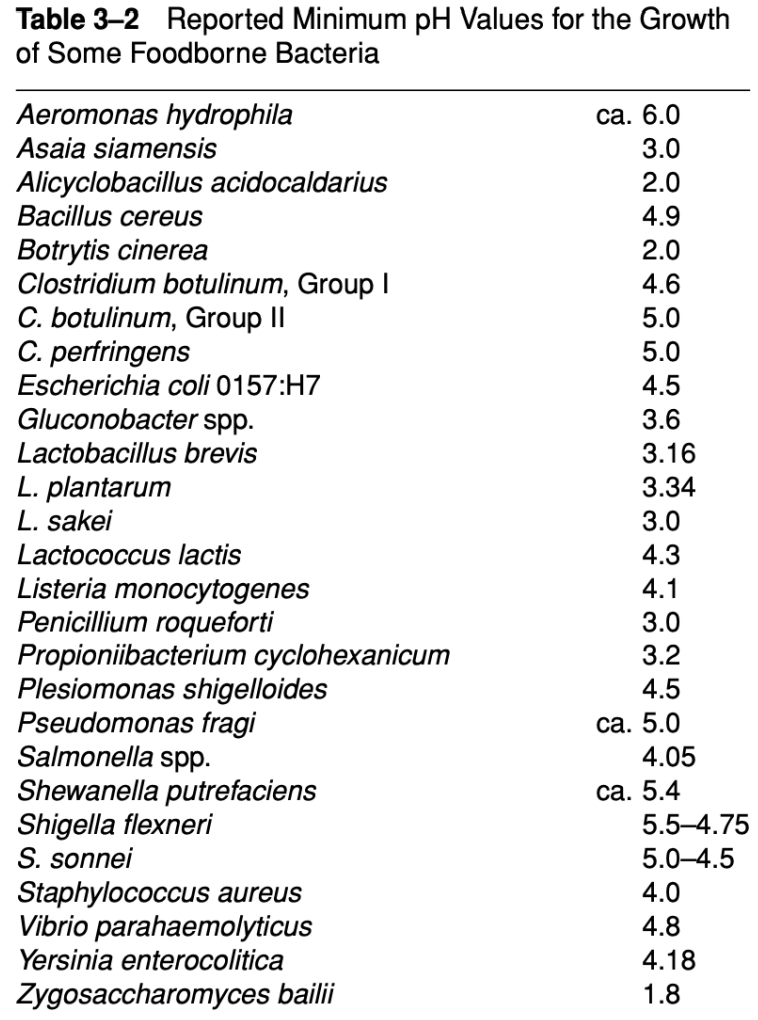
Fruits are generally _ in terms of pH and would most likely be spoiled by fungi
acidic
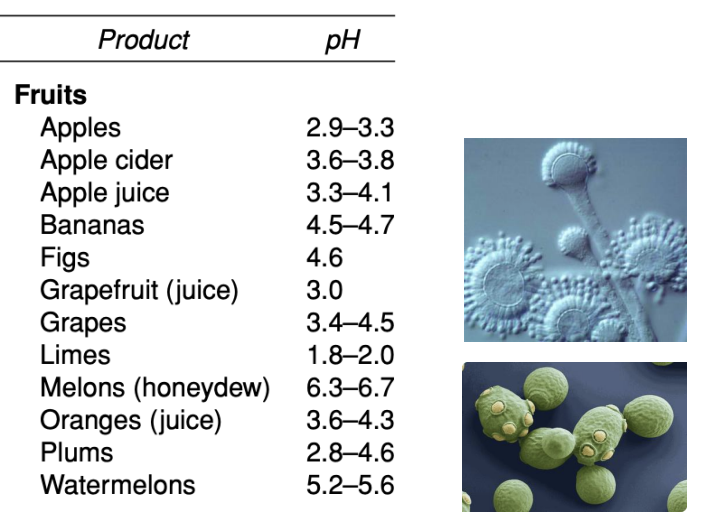
Vegetables are generally _ in terms of pH and thus would most likely be spoiled by bacteria
near neutral
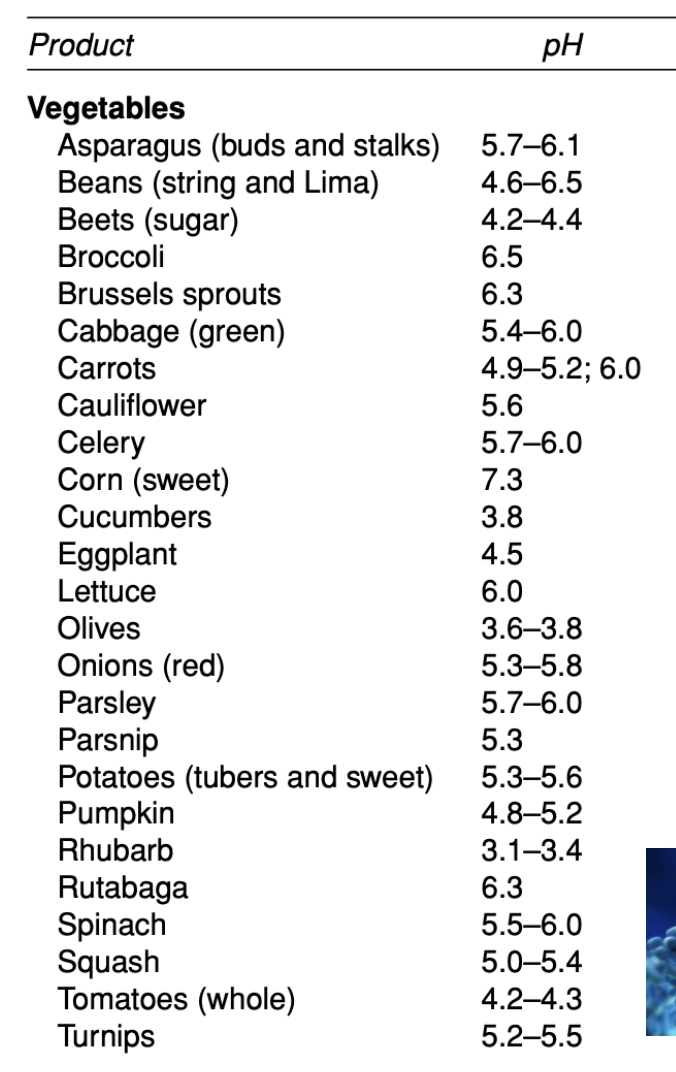
T/F: pH minima and maxima of microbes are fixed and cannot be influenced by other parameters
FALSE
pH minima and maxima of microbes are dependent on other growth parameters, e.g., moisture content—if a microbe is in a high moisture environment and thrives in that kind of environment, then they most likely can tolerate lower or higher pH than the typical range that they can tolerate (TLDR: increase in favorable growth conditions widen their pH tolerance range)
T/F: LAB is more acid tolerant in acetic acid than in HCl
FALSE
LAB is more acid tolerant in HCl than in acetic acid
Explain 2 situations where pH minima & maxima of microbes change depending on certain growth parameters
Alcaligenes faecalis when grown in
A = 1% peptone (moderate pH range)
B = 0.2 M NaCl (wider pH range)
C = 1% peptone + 0.2 M Na citrate (narrower pH range)
LAB is more acid tolerant in HCl than in acetic acid
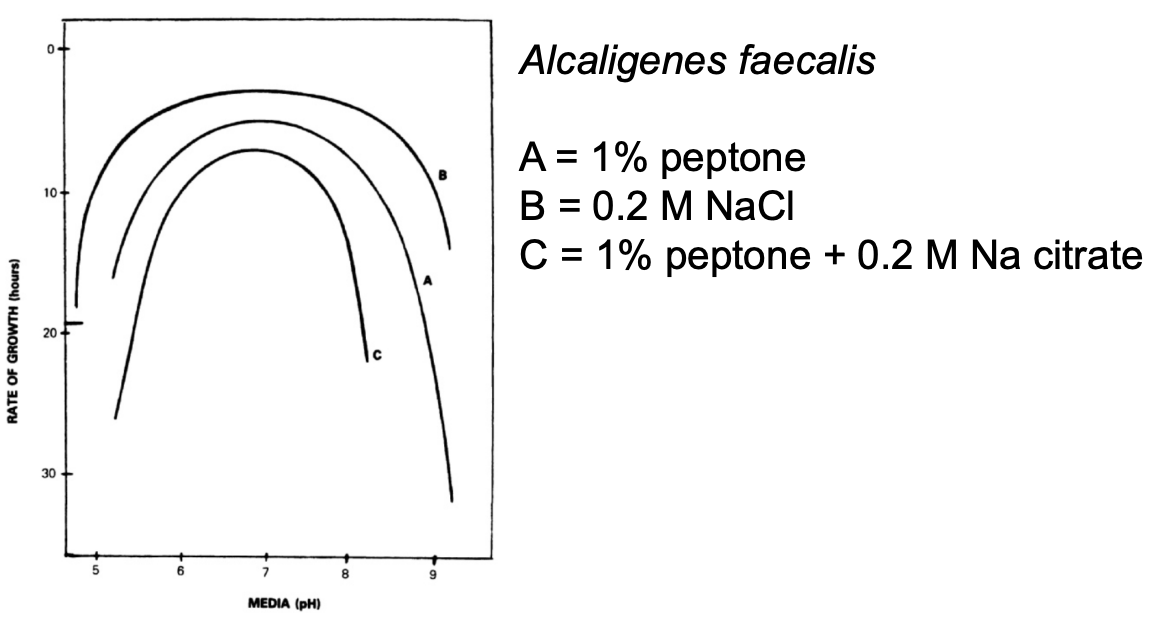
Fruits are generally acidic in terms of pH and thus would most likely be spoiled by _
fungi
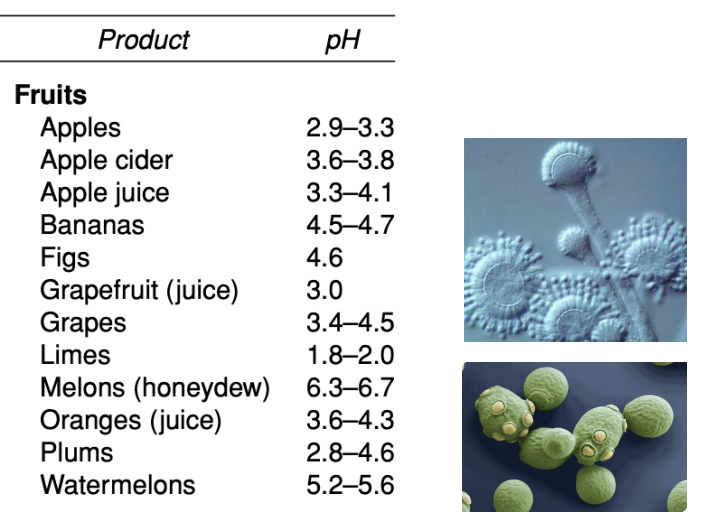
Dairy products, meat & poultry, and fish & shellfish dmf have pH ranging from _ and thus would most likely allow growth of and be spoiled by either bacteria or fungi
acidic to neutral
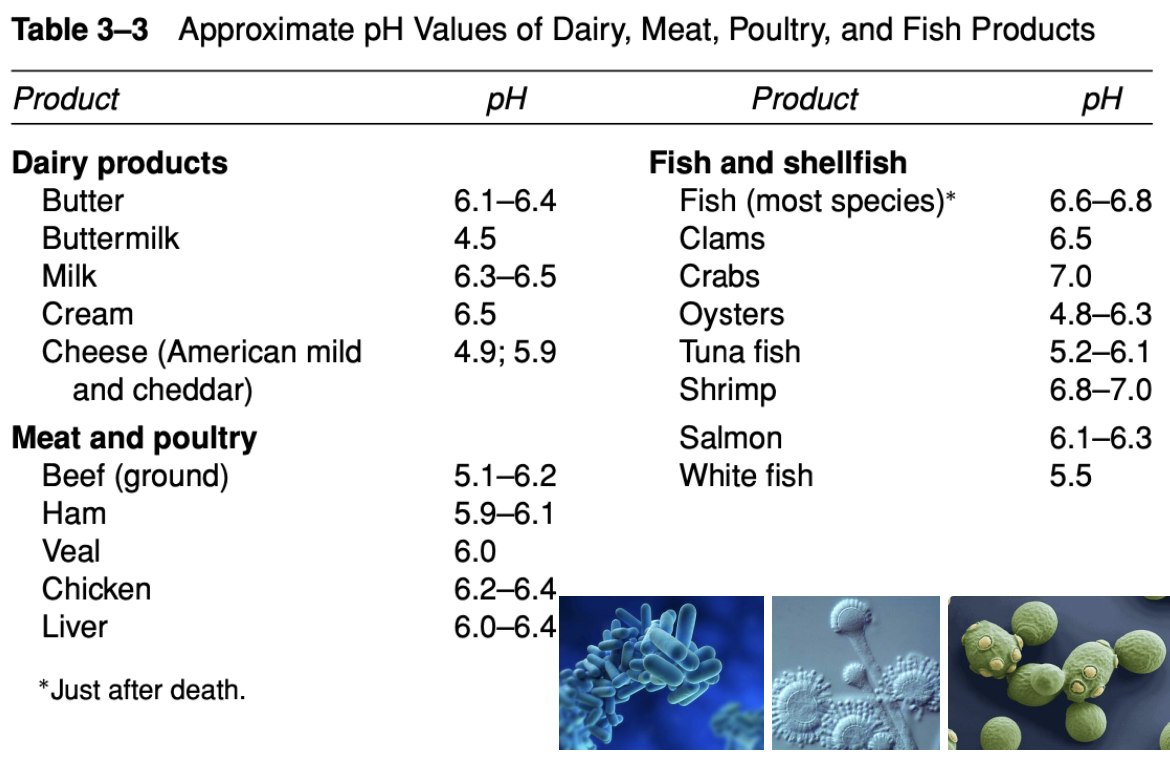
Vegetables are generally near neutral in terms of pH and thus would most likely be spoiled by _
bacteria
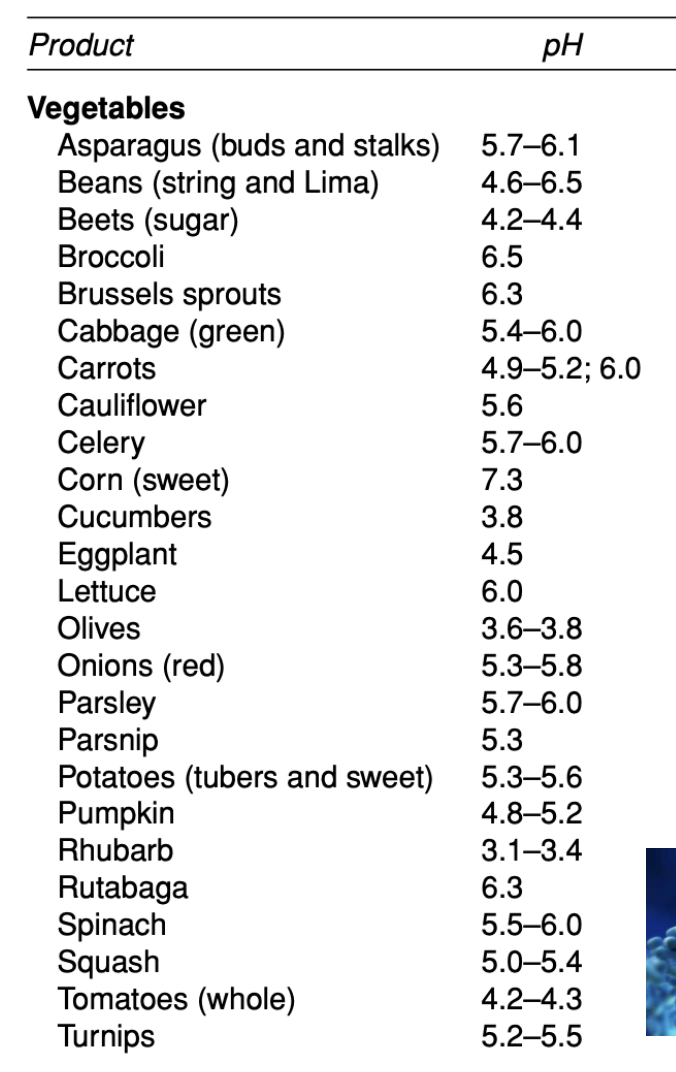
T/F: Vegetable soft rotting is more likely caused by fungi than bacteria
FALSE
Vegetable soft rotting is more likely caused by bacteria than fungi
*Soft rotting = Bacteria
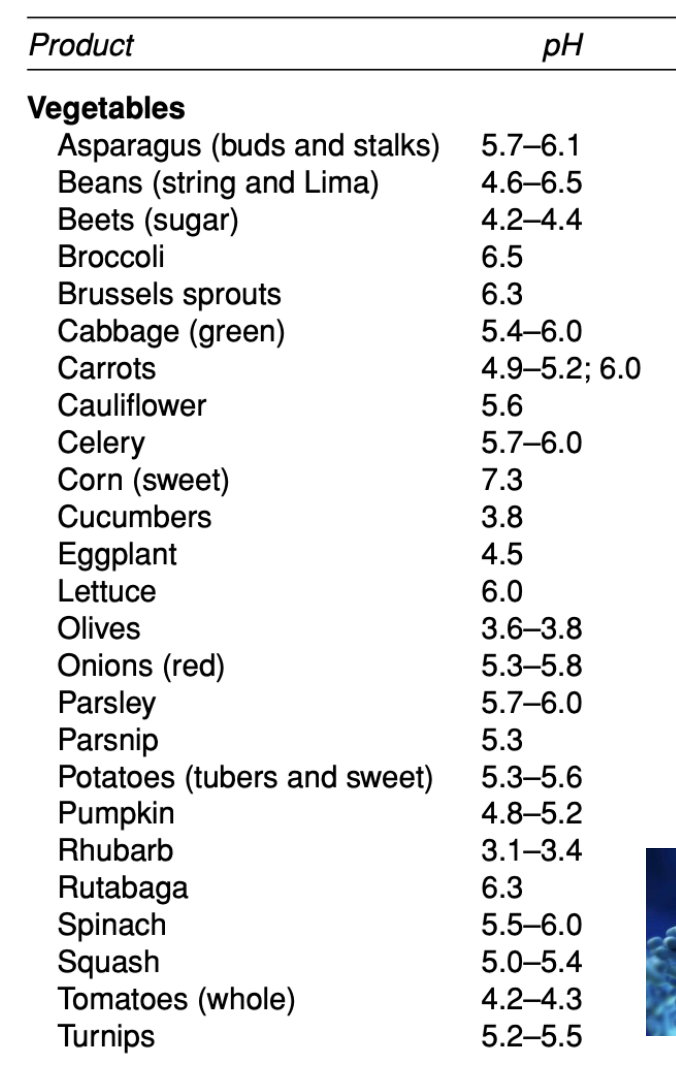
dmf Dairy products, meat & poultry, and fish & shellfish have pH ranging from acidic to neutral, thus allowing the growth of and may be spoiled by _
either bacteria or fungi (yeast/hyphal)
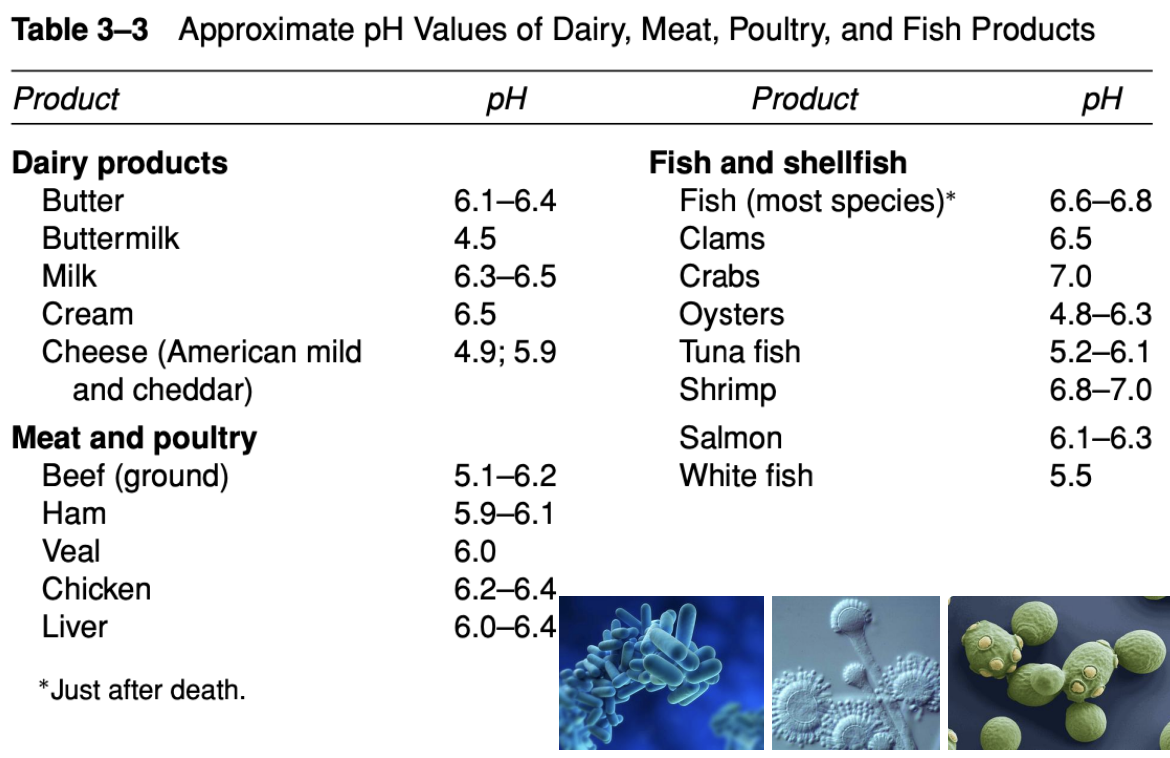
Which will spoil first: meat from a well-rested animal or fatigued animal? (pH intrinsic)
Meat from fatigued animal will spoil first due to a direct consequence of the final pH attained upon completion of rigor mortis
Meat from well-rested animal would have sufficient glycogen stored before slaughter, such that after slaughter, this produces sufficient lactic acid that lowers the pH and acidifies the environment, thus inhibiting microbial growth
Meanwhile, meat from fatigued animal would have depleted glycogen levels before slaughter, leading to less lactic acid produced after slaughter and thus ultimately resulting in a higher, more neutral pH that creates a more favorable environment for microbial growth
Give examples of food with biological activity (pH intrinsic)
Acidity or pH is due to the actions of certain microorganisms
Fermented milk, sauerkraut, pickles
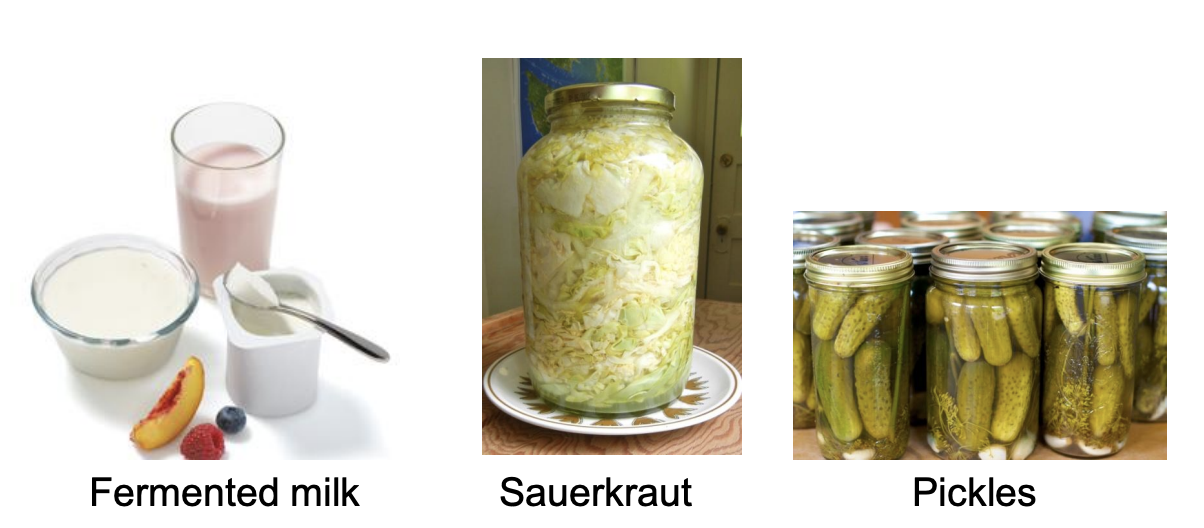
(pH intrinsic)
_ are foods that tend to resist changes in pH due to the buffering capacity of various proteins, resulting in low succession of microorganisms
Buffered food

T/F: Buffered foods are foods that do not undergo drastic changes in pH due to the buffering capacity of the proteins it contains
TRUE
T/F: Higher diversity of microorganisms is typically observed in spoilage of buffered foods
FALSE
Lower diversity of microorganisms is typically observed in spoilage of buffered foods because fewer changes in pH = fewer changes in microbial communities that can grow in it
T/F: There would most likely be higher succession of microorganisms in meat than in vegetables
FALSE
Meat would have lower succession due to it being a buffered food by virtue of the buffering capacity its proteins offer; vegetables, on the other hand, would likely have higher succession due to more fluctuating pH changes

T/F: Meats would have higher buffering capacity than veggies
TRUE
How does pH affect microorganisms?
Optimal pH is required for proper enzyme function and nutrient transport
Longer lag phase is observed when pH is nonoptimal
Morphology, e.g., Penicilium chrysogenum’s hyphal length is shorter when grown in pH > 6
Enumerate and explain microbial adaptations to extreme pH
Acidophiles mpah
Maintain cytoplasmic pH values nearer to neutrality
Pump protons out of their cells at a relatively high rate
Amino acid decarboxylase overexpression to consume cytoplasmic protons thru catalytic reactions
Highly impermeable cell membrane to restrict H+ influx
Alkaliphiles mt
Maintain cytoplasmic pH values nearer to neutrality
Transport reactions and flagellum rotation driven by sodium motive force instead of proton motive force (B. firmus)
_ refers to the ratio of the vapor pressure of food to vapor pressure of pure water at the same temperature
Water activity (Aw)
_ is an intrinsic parameter that pertains to water requirement of microorganisms
Pure water = _
Most fresh food = _
Water activity
Pure water Aw = 1
Most fresh foods Aw = 0.99
T/F: Even though acidophiles/alkaliphiles thrive in environments that are acidic/basic, their internal pH would still likely be similar to those of neutral range
TRUE
_ are enzymes that use the protons that enter the cell to catalyze biochemical reactions; used by acidophiles to adapt to extreme pH
Amino acid decarboxylases
T/F: Water activity is affected by concentration of salt solutions
TRUE
Water activity is inversely proportional to salt solution concentration; higher salt concentration = lower water activity & vice versa
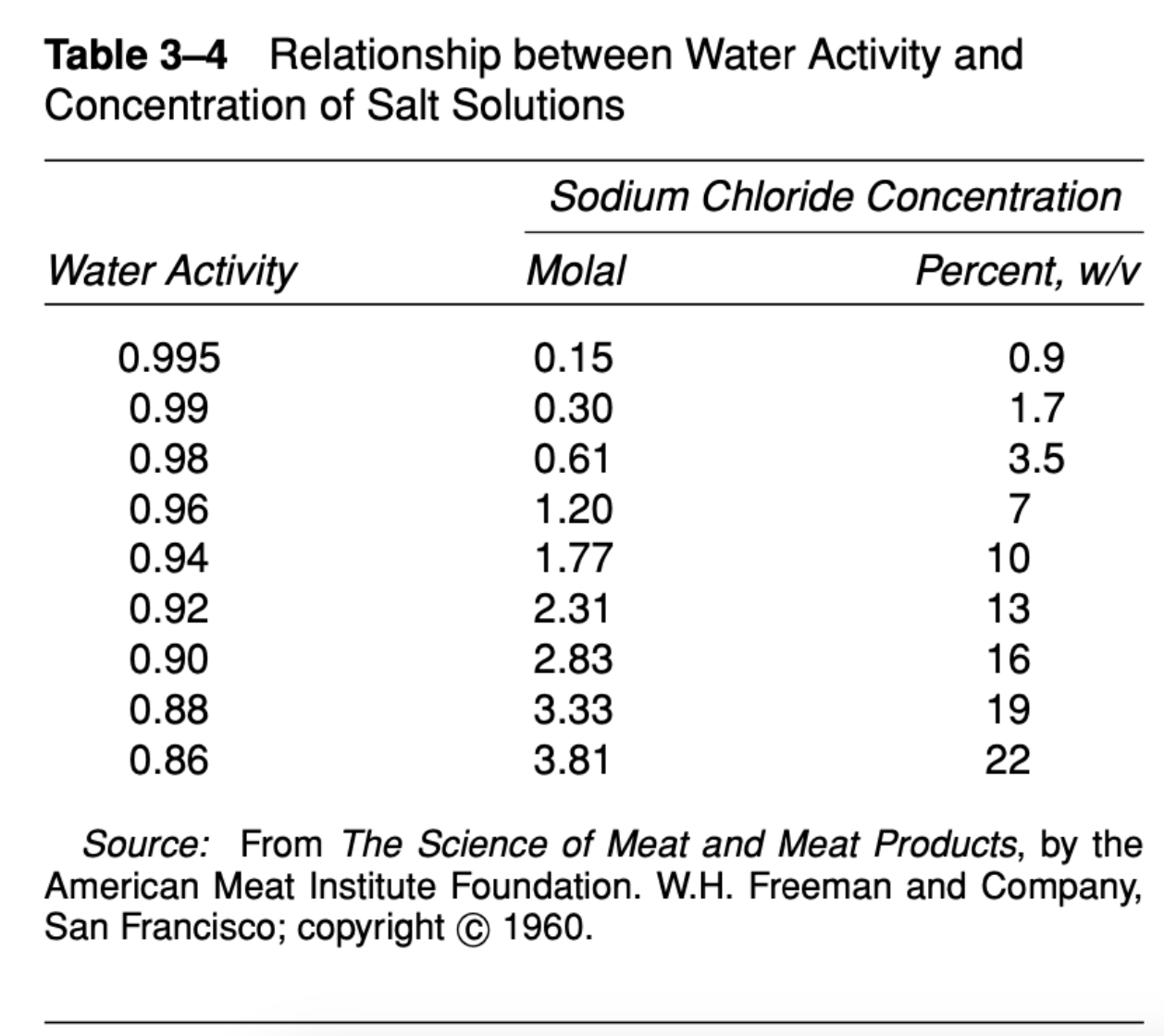
T/F: Most spoilage bacteria, yeasts, and molds would require Aw close to 1
TRUE
Spoilage bacteria = 0.9
Yeast = 0.88
Molds = 0.8
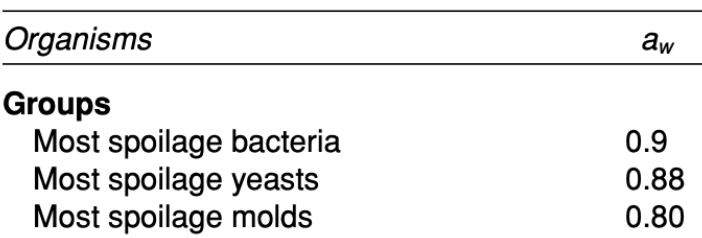
T/F: Halophilic bacteria require lower Aw than xerophilic molds and osmophilic yeasts
FALSE
Halophilic b = 0.75
Xerophilic molds = 0.61
Osmophilic yeasts = 0.61
T/F: Osmophilic yeasts would survive lower Aw than xerophilic molds
FALSE
OY = 0.61
XM = 0.61
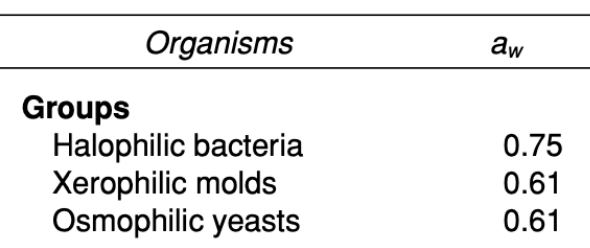
T/F: Generally, bacteria would require higher Aw than fungi; yeast & molds would survive a wider Aw range; and Gram-negative would require higher Aw than Gram-positive
TRUE
T/F: Generally, Gram-positive would require higher Aw than Gram-negative
FALSE
Gram-negative Aw > Gram-positive Aw

T/F: Yeast & molds require higher Aw than bacteria
FALSE
Bacteria Aw > Fungi Aw

T/F: Yeast and molds have wider pH and Aw range
TRUE
Enumerate and explain factors related to or affecting Aw
tnp
Low Aw = reduced ability to grow any temperature
Wider range of Aw = optimum temperature & nutrient
Higher minimum Aw requirement = nonoptimal pH
T/F: Being in a low Aw environment can lead to increased ability to grow any temperature
FALSE
Being in a low Aw environment can lead to decreased ability to grow any temperature
T/F: A nonoptimal temperature and nutrients can lead microbes to have a wider Aw range
FALSE
Optimal temperature and nutrients can lead microbes to have a wider Aw range
T/F: A nonoptimal pH can result in higher minimum Aw requirement in microbes
TRUE
Enumerate and explain effects of low Aw on microorganisms
olgpa
High osmotic stress
Longer lag phase
Decreased growth rate
Decreased population size
Adverse effect on all metabolic activities
Enumerate and explain adaptations of microbes to low Aw environments
Keep their cell membrane fluid
Ability to concentrate salts, polyols, amino acids spa
Prevents the cells from losing water
Allows the cell to extract water from water-depressed external environments
T/F: Some microbial adaptations to low Aw include keeping cell membrane rigid and concentrating salts, polyols, & amino acids to not only prevent cells from losing water but also allow cells to extract water from water-depressed external environments
Some microbial adaptations to low Aw include keeping cell membrane fluid and concentrating salts, polyols, & amino acids to not only prevent cells from losing water but also allow cells to extract water from water-depressed external environments
T/F: O/R (Eh) is a consideration when dealing with aerobes
FALSE
O/R (Eh) is a consideration when dealing with anaerobes because lower Eh would allow anaerobes to survive
_ is the intrinsic parameter that pertains to the ease with which a substrate loses or gains electrons
Oxidation-reduction potential (Eh)
T/F: A compound that loses electrons is oxidized and a compound that gains electrons is reduced
TRUE
Oxidation = lost; reduction = gained OILRIG
Explain oxidation-reduction potential as an intrinsic parameter
Ease with which substrate loses or gains electrons
Expressed by the symbol Eh
+ Eh values (oxidized) → aerobes
- Eh values (reduced) → anaerobes
Zero Eh values → [oxidant] = [reductant]
T/F: Pre-rigor meat would have lower Eh, while post-rigor meat would have higher Eh
FALSE
Pre-rigor meat would have higher Eh (higher O2 supply), while post-rigor meat would have lower Eh (lower O2 supply)
T/F: Highly oxidized (+Eh) food would favor anaerobes, highly reduced (-Eh) food would favor aerobes
FALSE
Highly oxidized (+Eh) food would favor aerobes, highly reduced (-Eh) food would favor anaerobes
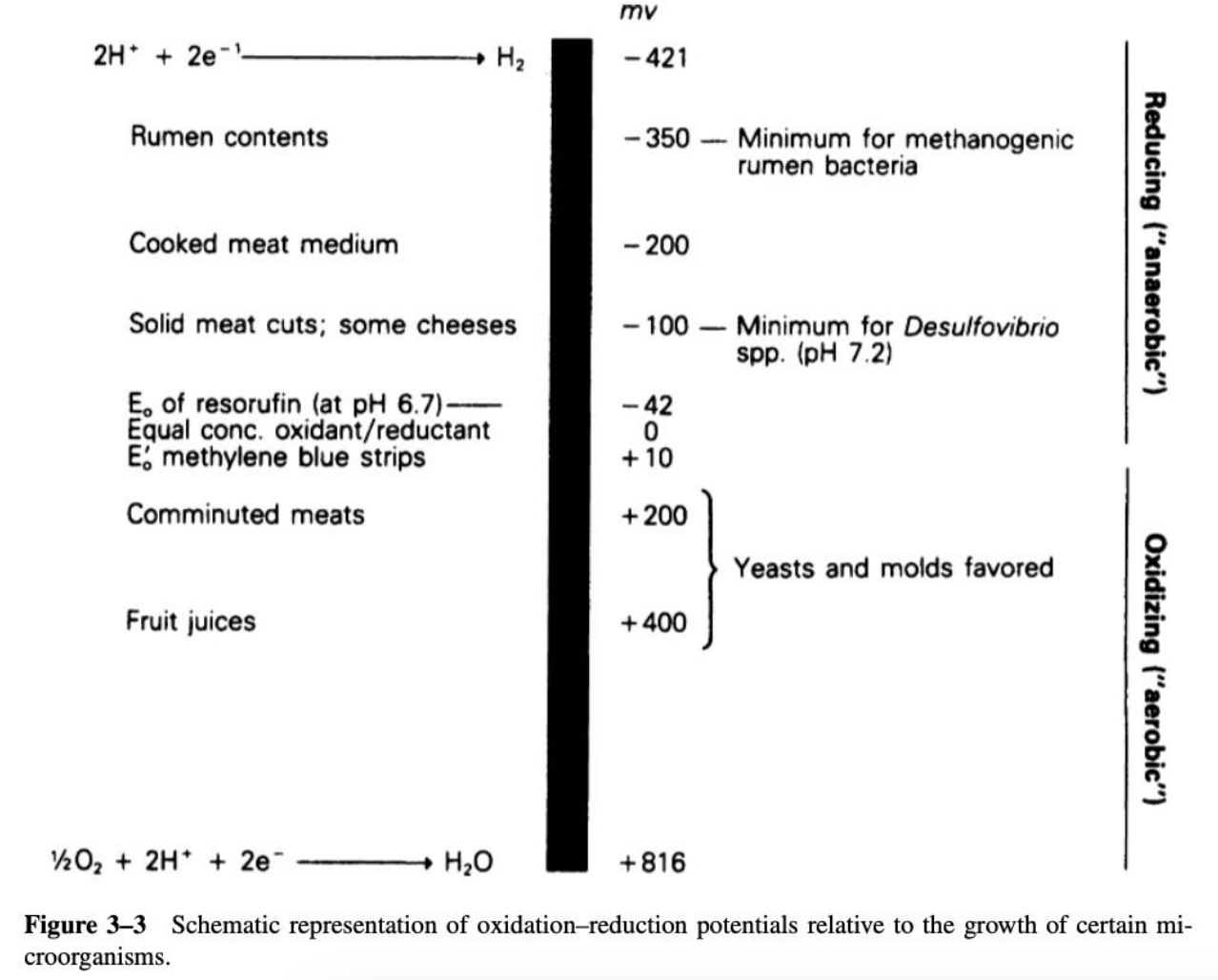
Explain oxidation-reduction potentials (Eh) relative to growth of certain microorganisms
-Eh = reducing (anaerobic)
-350 rumen contents → min. for methanogenic rumen bacteria
-200 cooked meat medium
-100 solid meat cuts & some cheeses → min. for Desulfovibrio
[oxidant] = [reductant]
0
+Eh = oxidizing (aerobic)
Favors yeasts & molds
+200 comminuted meats (mechanically processed into smaller pieces, such as ground, chopped, or emulsified meat, e.g., ground beef, sausages, hot dogs, patties, etc.)
+400 fruit juices
![<p></p><p><strong>-Eh = reducing (anaerobic)</strong></p><ul><li><p>-350 rumen contents → <em>min. for <u>methanogenic rumen bacteria</u></em></p></li><li><p>-200 cooked meat medium</p></li><li><p>-100 solid meat cuts & some cheeses → <em>min. for <u>Desulfovibrio</u></em><br></p><p>[oxidant] = [reductant]</p></li><li><p>0 <br></p></li></ul><p><strong>+Eh = oxidizing (aerobic)</strong></p><p><em><u>Favors yeasts & molds</u></em></p><ul><li><p>+200 comminuted meats <em>(mechanically processed into smaller pieces, such as ground, chopped, or emulsified meat, e.g., ground beef, sausages, hot dogs, patties, etc.)</em></p></li><li><p>+400 fruit juices</p></li></ul><p></p>](https://knowt-user-attachments.s3.amazonaws.com/c7a8438f-14ec-420a-8847-e17306aca87c.png)
T/F: Comminuted meats spoil faster than solid meat cuts because their higher Eh makes them more prone to oxidation and aerobic microbial growth
TRUE
T/F: Desulfovibrio spp. are more likely to grow in fruit juices than in solid meat cuts
FALSE
Desulfovibrio spp. require an Eh of around -100 mV (solid meat cuts & some cheeses), while fruit juices have a highly oxidizing environment (+400 mV), making it unsuitable for their growth
T/F: Methanogenic bacteria can survive in comminuted meats because of their relatively low Eh
FALSE
Methanogens require a highly reducing environment (< -350 mV), whereas comminuted meats have an Eh of +200 mV, which is far too oxidizing for them
T/F: Yeasts and molds are more likely to grow in fruit juices than in cooked meat medium
TRUE
Yeasts and molds thrive at higher Eh values (>+200 mV), which matches the oxidized environment of fruit juices (+400 mV), whereas cooked meat medium is more reducing (~-200 mV)
T/F: The oxidation-reduction potential of a food product can shift over time due to microbial activity, making it more favorable for different microorganisms at different spoilage stages
TRUE
Foods rich in -SH groups (sulfhydryl / thiol) in meats and ascorbic acids would create a _ environment, favorable for growth of _
reducing = anaerobes
T/F: Reducing sugars in fruits and vegetables are best suited for growth of anaerobes
TRUE
Enumerate and explain effects of microbes on Eh (O/R potential)
Aerobes can lower Eh of their environment
O2 is depleted in the medium
The medium becomes poorer in oxidizing and richer in reducing substances
Metabolic byproducts, e.g., H2S, can lower Eh
T/F: Aerobes can lower Eh of their environment by depleting O2 in the medium, resulting in medium becoming poorer in reducing and richer in oxidizing substances
FALSE
Aerobes can lower Eh of their environment by depleting O2 in the medium, resulting in medium becoming poorer in oxidizing and richer in reducing substances
Metabolic byproducts, e.g., _, can lower Eh
Hydrogen sulfide (H2S)
T/F: Eh can influence what type of microorganisms grow in the environment, at the same time, microbes can change Eh and influence what type of microbes grow in the environment
TRUE
_ is the intrinsic parameter that concerns itself with source of energy, carbon, nitrogen, vitamins & minerals
Nutrients
T/F: Almost all natural foods have an abundant quantity of vitamins and minerals for those unable to synthesize their own essential requirements, e.g., Gram (+)
TRUE
Rank ff. in terms of nutrient requirements
Yeast
Molds
Gram (+)
Gram (-)
Gram (+) > Yeast > Gram (-) > Molds
T/F: Gram (+) bacteria and molds can synthesize their own vitamins and minerals
FALSE
Gram (-) bacteria and molds can synthesize their own vitamins and minerals; Gram (+) needs to be supplied with vitamins and minerals
Enumerate 3 sources of energy and carbon
saacf
Sugars, alcohols, amino acids
Complex carbohydrates
Fats

Enumerate 3 primary sources of nitrogen
nap
Nucleotides
Amino acids
Peptides and proteins
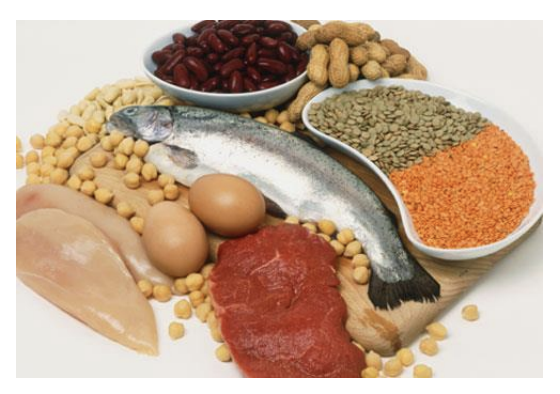
_ refers to the type of nutrient that includes growth factors required in low quantities
Almost all natural foods have an abundant quantity of these for those unable to synthesize their own essential requirements
Need to be supplied to Gram (+)
Can be synthesized by Gram (-) and molds
Vitamins and minerals
_ is the intrinsic parameter that refers to naturally occurring substances that possess and express antimicrobial activity and thus contribute to food stability
Antimicrobial constituents
Give 4 examples of antimicrobial constituents (intrinsic)
elml
Essential oils, e.g., allicin in garlic
Lactoferrin in cow’s milk (iron-binding glycoprotein)
Milk casein
Lysozyme in eggs and milk
_ is the intrinsic parameter that provides excellent protection against the entry and subsequent damage by spoilage organisms; usually refers to natural covering of the food
Biological structures
Give 5 examples of biological structures (intrinsic)
tosh s
Testa of seeds
Outer covering of fruits and nuts
Shell of eggs
Hides of animals
Scales of fish
_ refers to properties of the storage environment affecting both the foods and their microorganisms
Extrinsic process variables
Enumerate and explain 3 extrinsic process variables
Storage temperature
Most important extrinsic parameter that affects spoilage of highly perishable foods
Dependent on temperature growth range of
Foodborne pathogens
Spoilage microorganisms
Maintenance of food quality must also be considered
Relative humidity of storage environment
Affects the Aw within food
Affects ability of microbes to grow at food surfaces
Aw food is directly proportional to RH storage but inversely related to temperature storage
Low Aw food = Low RH storage = High temp storage
High Aw food = High RH storage = Low temp storage
Gases
Influences growth of microorganisms
CO2 controls microorganisms in foods
O3 has antimicrobial properties
Presence & activities of other microorganisms
Some foodborne pathogens produce substances that are either inhibitory or lethal to others
e.g., abho antibiotics, bacteriocins, hydrogen peroxide, organic acids
_ is the most important extrinsic parameter affecting spoilage of highly perishable foods
Storage temperature
Storage temperature is dependent on the _
temperature growth range of foodborne pathogens and spoilage microorganisms; maintenance of food quality must also be considered
_ affects Aw within food and the ability of microbes to grow at food surfaces; directly related to Aw but inversely related to temperature storage
Relative humidity of storage environment
_ influence growth of microorganisms, such that CO2 may control microorganisms in foods, while O3 may have antimicrobial properties
Gases in the storage environment
_ is an extrinsic parameter that considers some substances produced by foodborne pathogens, including antibiotics, bacteriocins, hydrogen peroxide, organic acids
Presence & activities of other microorganisms
_ refers to microbial interactions, including cmmca competition, metabiotic, mutualism, commensalism, and antagonism, as well as beneficial and adverse effects of such interactions
Implicit microbial characteristics
Microbial interaction where 2 or more microorganisms help one another
Metabolic byproducts as growth requirement
e.g., Lactobacillus arabinosus gets Phe, which it cannot synthesize, from Enterococcus faecalis, while E. faecalis gets folic acid from L. ara
Mutualism
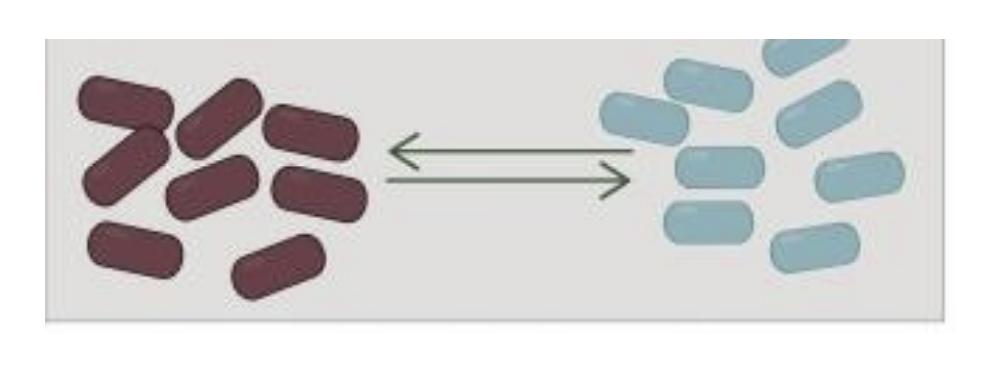
Microbial interaction where there is limited energy and nutrient resources
Outcomes depend on growth rate of competitors, such that
Fast-growing outcompetes slow-growing microorganisms
Can lead to competitive exclusion (i.e., complete inhibition of slow-growing)
Competition
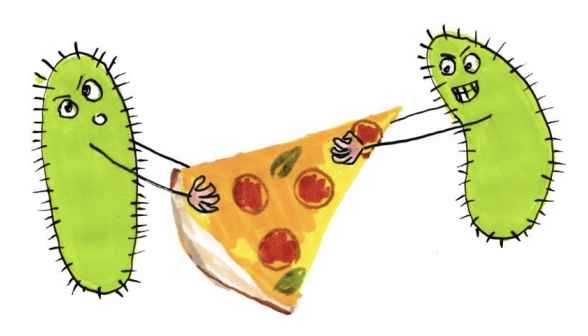
Microbial interactions where one benefits from the other, while the other is neither harmed nor benefitted
e.g., Vinegar production
S. cerevisiae produces ethanol (alcohol) from sugar
Acetobacter aceti uses ethanol to produce acetic acid
Commensalism
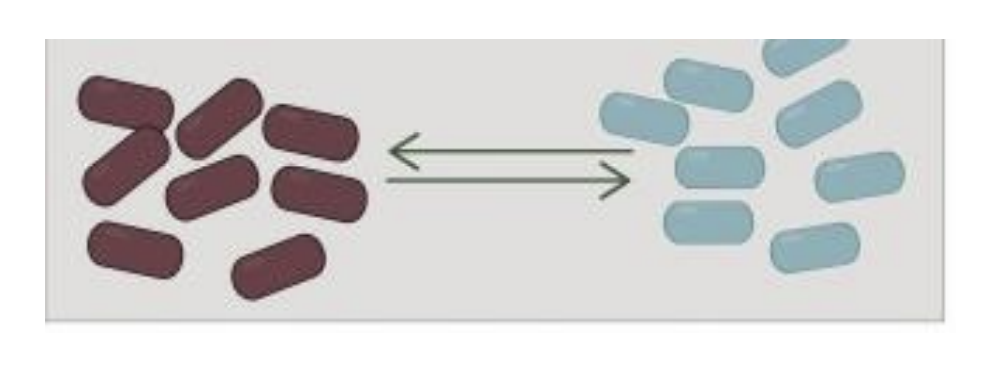
Microbial interactions where changes in food is due to metabolic activity of predominant microorganisms
Succession of microorganisms icc
Initial optimal growth of 1 or 2 types
Creates an environment not optimal for their growth
Creates changes in envi favorable for other types of microorganisms
Metabiotic
Give examples of metabiotic microbial interactions
Ground meat in an air-tight bag
Aerobes grow first
Colonization of anaerobes follows
Manufacturing > Ripening > Cheese variety
les > dg > aps
Manufacturing (Pasteurization, Cutting, Whey drainage, Salting)
LAB, Enterobacteriaceae, Staphyloccus
Ripening (Temperature, Time, Humidity)
Debaryomyces, Geotrichum
Cheese variety
Fresh
Soft
Hard
Smear-ripened
Blue-veined
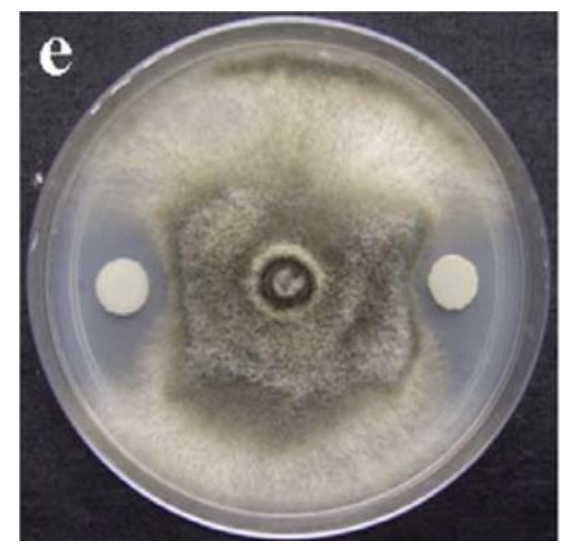
Microbial interaction where microorganisms adversely affect each other in growth environment
One may kill the other
Production of antimicrobial components
e.g., Nicin of L. lactis killing other Gram (+) and inhibiting other Gram (-)
Antagonism